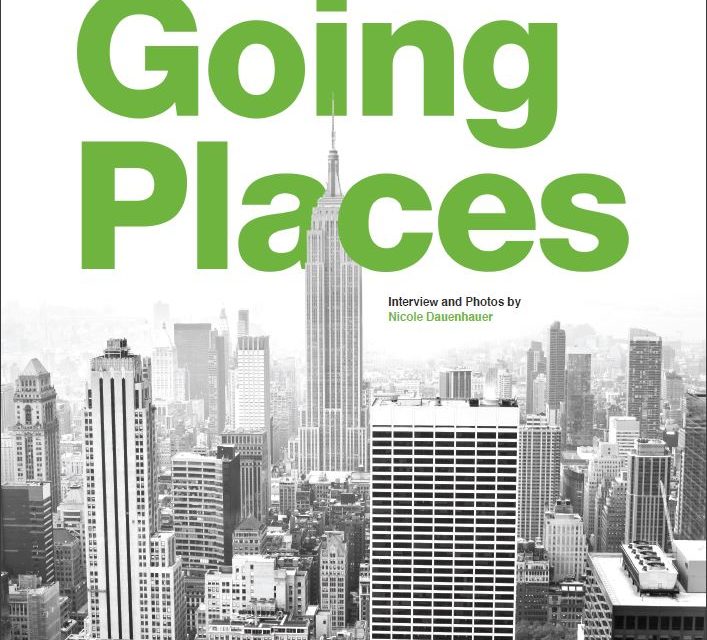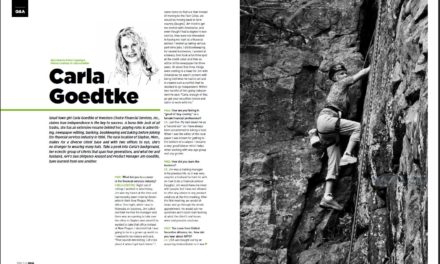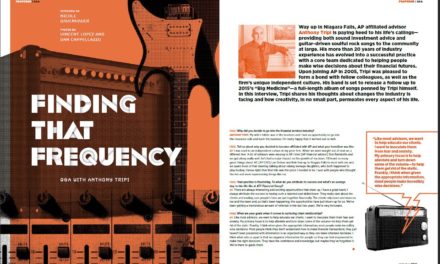
FREE 13.1 Q&A: Jared McGill
From waiting tables at East End Long Island restaurants to joining AP as a new accounts associate, McGil worked his way up through the ranks—building enough confidence to strike out on his own as an investment professional. Now, married with two children, he makes his home in Westport, Conn., and commutes each day to Blank Financial, a Park Avenue Manhattan practice where he works alongside mentor and fellow investment professional Greg Blank to provide solution-driven advice to their loyal client base.
To view the full article please register below:
FREE 13.1 Q&A: Jared McGill
American Portfolios (AP) affiliated investment professional Jared McGill has worn many different hats … all of which groomed him to be exactly where he is now. From waiting tables at East End Long Island restaurants to joining AP as a new accounts associate, McGil worked his way up through the ranks—building enough confidence to strike out on his own as an investment professional. Now, married with two children, he makes his home in Westport, Conn., and commutes each day to Blank Financial, a Park Avenue Manhattan practice where he works alongside mentor and fellow investment professional Greg Blank to provide solution-driven advice to their loyal client base. In 2018, McGill donned yet another hat—that of AP Advisor Council (APAC) member, a role he lends his no-holds-barred style to with rapier-like wit and passionate commitment. In this issue’s Q&A, we sit down with McGill to talk about the progression of his career, his present experiences and what the future may hold.
FREE: You’ve been around almost from AP’s inception as an independent broker/dealer (IBD). Tell us how you got your start with the firm and about the roles you played.
Jared McGill: I was introduced to [CEO] Lon Dolber through a friend of the family, and started at AP in 2004. I think there were about 20 people at the time, so I was one of the first people reviewing new account forms (NAFs)—making sure they matched what people filled out versus what was entered on the screen. My role kind of evolved from there and I helped build out the new accounts department with [COO] Dean Bruno. I also helped build out STARS by providing ideas and brainstorming, while working closely with the technology team. We made sure the platform was userfriendly and that the interface made sense. My biggest role was saying this works or doesn’t work, and then they would bring it back to the programmers. From there, we opened all the brokerage accounts; the business processing module (BPM) was also established when I was there.
FREE: While you were at the AP home office, you worked on getting licensed. What was that process like?
JM: I had a weird experience with my FINRA test. Not to sound arrogant, but I like to think of myself as fairly intelligent; passing a test shouldn’t be something that I would struggle with generally. I took the exam and failed, took it again and failed, and then took it again and passed. One evening, a few months after I passed the Series 7, I was at happy hour with [Sales and New Business Development Consultant] Carl Kirchner and some colleagues when Lon called my cell phone at maybe 6 p.m.; my first thought was, “This is probably not good.” Dean was also on the call, along with [former CCO] Frank Giacchetto. They introduced me to a FINRA contact who was also on the line. I had no idea what this was about, and wondered how I could be in this much trouble. I didn’t even do anything yet! Long story short, the FINRA contact said, “There’s been a grading error on your test.” So, naturally I thought I failed again. Instead, she told me, “You passed all three times and we have to update the CRD.”
FREE: You have got to be kidding me. That’s incredible!
JM: There was a small batch of grading errors. Maybe thousands of people took it in the same timeframe and a small percentage–perhaps a couple hundred people–were affected by this software glitch. They wrote me this big apology letter.
FREE: It’s somewhat validating to know that you did pass that first time and all the times after that, but still, that’s crazy.
JM: You go through the failure of it and everyone knows that you’re taking this test. You’ve got to come back and be like, “Yup, I’m an idiot … twice.” So, it was kind of a kick to my confidence, which maybe I needed once in a while [back then].
FREE: From there, how did you build your book of business?
JM: I was running into people, my friends and family, asking if I could do a Roth IRA or a rollover—because they just didn’t have anyone. I asked Lon if I could build a book of business after work hours and he told me to go for it; that it would be a good experience for me. So, I was building a book while also working at AP for a few more years. I was also training advisors at that time so that when I left the home office, I had been managing new accounts, relationship management and transitions. As my book was growing, I saw an opportunity in 2010 when the market rebounded a bit. I didn’t have a family, I didn’t have much that I had to really worry about, so I said I’m just going to try it. I went out to New York City and worked with Penn Plaza Associates. They gave me a desk in exchange for helping them transition at the same time from their broker/dealer.
FREE: After working with Penn Plaza Associates, you made the move over to Blank Financial?
JM: Greg Blank wasn’t far from me location wise, so we would sit down to collaborate and share ideas. In July 2011, I joined Greg and we built out a space. We were both pretty young at that point; there’s not a lot of young, standalone independent advisors.
FREE: What was it like to transition from once servicing investment professionals in the home office to actually being one yourself?
JM: I knew how to process the business, so I didn’t have to learn any of that; more importantly, I knew what the upside was. Having helped build the system, all I had to do was put the paperwork through—that was the easy part. I just had to get clients. You need to have a certain personality if you want to be on the advisor side; you have to have confidence, and maybe a little arrogance, to do it.
FREE: Let’s talk about your client base a little bit: who are they, what are your relationships with them like, and how do you retain and acquire them?
JM: Most of my clients are my age demographic—early to late 30s; once in a while their parents want a new start and their children will say, “You should talk to my guy.” I’m targeting in New York City, and it’s obviously a bit of a bubble, but I’m targeting people who are more casual—social media users, self-proprietors, building apps—that sort of thing. I have young clients that work at Google, Twitter and so on who make a very healthy salary. For some reason, advisors are not going after that demographic.
FREE: What’s the advantage of working with Millennials?
JM: Sometimes the younger clients who are making a bunch of money go unnoticed because some older advisors don’t really want to work with Millennials. All of my clients are in the accumulation phase; they’re all stacking their chips. The older clients are taking the money out. My book is only going up. If you don’t replace the distribution phase with anything on the accumulation phase, you’re just going to devalue your book as you go.
FREE: How do you run your practice, in terms of your product mix? And, how has it changed over the years?
JM: I’ve been pretty straightforward on my product selection. Lon was a great mentor to me. When I got my first account I asked him what fund family to use. He said to pick one fund family and keep it simple. I’ve applied that the whole way through. I do use more than one fund family now, but I don’t use third-party money managers. I pick mutual funds with low expenses, since the younger generation is looking for that. I have to align with their preference and just keep it simple. I’ll use Vanguard S&P 500, I’ll use a Fidelity fund … I’ll use things that are inexpensive to run, but have upside [potential] and people know them. I also use Portfolio Insight to build models; I have a couple of models that I apply to each client depending on their goals, time horizon, etc. I hit a button, do the trades and it’s done.
FREE: Can you speak to the advantages that being independent affords you as an investment professional?
JM: First and foremost, I can create my own personal brand. You can essentially create a brand based on your own being, your own nature, whereas at a wirehouse, you have to wear a tie up to your chin and be a puppet—and I’m just not good at that, period. I wouldn’t last in this business if I worked at a wirehouse. Being independent gives you the ability to be accountable for yourself and make your own money—no one’s telling you what to sell, what to do or how you should dress. Most importantly, what did you do for your client? I’m in this business to make money for my clients, not just for myself. You’ll be successful if you hang in there long enough and do what’s right for each client.
FREE: Recently, you became a member of the AP Advisor Council (APAC). What motivated you to become involved?
JM: I was interested because, when I worked in the AP home office, I did have a passion for trying to create better user interfaces for advisors. I think it’s important on the system side that things are intuitive. I wanted to get in front of that and help.
FREE: You provide a unique perspective, as a member of APAC’s priorities and initiatives committee, because you have that foreknowledge of working behind-the-scenes in the home office and now being out in the field.
JM: On the committee, we handle all the comments, concerns and requests that come in for the technology platforms. We have a call every Tuesday with the home office group and we create a workflow. After I give the rep view of it, they kind of take it from there. APAC is like a union mentality for the advisors; we represent the advisors to the home office as a group, and the more feedback we have from the field, the more we can give to the home office to digest. We need feedback based on their experience and their frustrations, as well as what good experiences they’re having.
FREE: What’s one topic that you’d like to bring to the forefront for fellow advisors and their clients?
JM: Trying to get this business more environmentally aware by going paperless. For the younger generation that will be investing with us and want no paper, we have a responsibility to make sure we are not negatively impacting the environment. We need to press this issue and reduce our carbon footprint. It’s a responsibility we have in this industry because stuff is getting printed that’s not being read. Better it be online where clients can access and read it there whenever they want and not feel guilty about so many trees getting cut down.
Editor’s Note: In the latter portion of 2018, AP launched a firm-wide Corporate Sustainability Campaign, which includes client opt-out of paper mailings through HomePort – Client Access.
FREE: What’s the best piece of advice anyone’s ever given you?
JM: The maitre’d at one of the restaurants in the Hamptons where I worked told me you need to look everyone in the eye and say hello when you arrive to each shift. That enlightened me in more ways than I knew at the time. In terms of the financial aspect of my life, Lon’s advice about keeping the investment side of things simple has served me well.
FREE: What do you do in your spare time?
JM: I like to collect a lot of vinyl, play golf, paddle board and go out on the water—stuff like that. I play the guitar, but not very well. I have two kids, so I don’t have much time to put in an hour of practice a day.
FREE: The theme of this issue is “building momentum.” Given the trajectory of your career, what are your thoughts on building momentum in your business?
JM: For me, it’s about organic relationships and harvesting the relationships you have. I probably get three to four referrals a month from either an accountant I work back and forth with, or clients. I get a warm introduction almost once a week, at least. The momentum is a snowball—the more people you know, the more people you get introduced to. It’s just doing right by your clients, doing what you’re supposed to do for them; if you do that, then when they lunch with a friend, they may drop your name and send an e-mail to introduce you. That seems to be the best way for me.
FREE: What motivates you in life, in business and in general?
JM: I feel like I help people solve their problems. Being able to help people put things together, making sure they don’t run out of money in retirement, is something I feel good about. Really, that’s what motivates me. For most people, the first priority in life is health, and the second seems to be money. To help someone with their second biggest thing in life feels pretty good.
FREE: Lastly, what are your plans for the future, both professionally and personally?
JM: I want to have a good, healthy, vibrant family, and contribute to the community. I don’t get obsessed with the future; it’s day-to-day for me, just managing my little kids.
FREE: Thanks for sharing your thoughts with us, Jared. It’s been a pleasure.
JM: Thanks so much.












